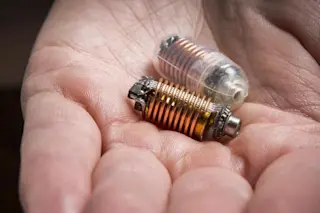A close up of the swallowable sensor. (Photo: Peter Clarke/RMIT University) Your nose, mouth, skin pores and…other…body holes each serve their unique functions. But most of them also double as biological exhaust pipes, spewing gaseous byproducts of the myriad internal chemical reactions keeping you alive. And, just as we measure emissions form our internal-combustion vehicles, advances in medical technology make it easier to analyze the gases you leak into the atmosphere. Scientists at RMIT University in Australia developed a pill-sized sensor that measures hydrogen, carbon dioxide and oxygen gases circulating in the gut—and in real-time. Temperature and gas sensors, batteries, antennas and a wireless transmitter are all sealed within a gas-impermeable shell. One end of the device—you might call it the nose—features a small, gas-permeable membrane, which allows the sensor to get a whiff of its surroundings. Every 5 minutes, the device beams back data about gas concentrations to another ...
Fart-Sniffing Pill Reveals Secrets of the Gut
Discover how a swallowable sensor measures gut gas concentrations in real-time, offering insights into gut health and microbiome activity.
More on Discover
Stay Curious
SubscribeTo The Magazine
Save up to 40% off the cover price when you subscribe to Discover magazine.
Subscribe













